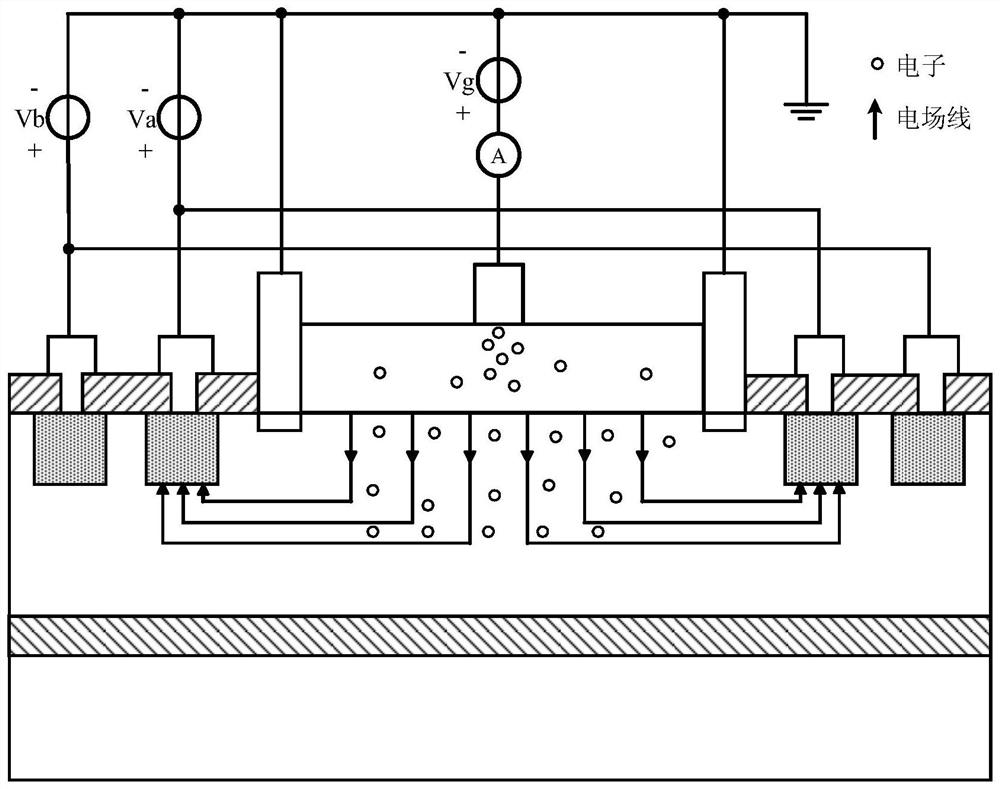Thermo-electron effect test structure based on HEMT device and characterization method thereof
A thermionic and effect technology, applied in single semiconductor device testing, semiconductor/solid-state device testing/measurement, semiconductor devices, etc., can solve the problem of uneven distribution of hot electrons, inability to independently study the degradation of device performance, and lack of mechanisms for thermionic effects Research and characterization and other issues to achieve the effect of studying thermionic effect
- Summary
- Abstract
- Description
- Claims
- Application Information
AI Technical Summary
Problems solved by technology
Method used
Image
Examples
Embodiment 1
[0054] See figure 1 , figure 1 A structural schematic diagram of a thermal electron effect test structure based on a HEMT device provided by an embodiment of the present invention. This embodiment takes a HEMT device as an example, a test structure based on a heterojunction device, which is characterized in that it includes: a substrate 1, a nucleation layer 2, a buffer layer 3, a barrier layer 4, a gate 5, source 6, drain 7, first doped region 9, second doped region 10, electrode A11 and electrode B12, wherein,
[0055] The nucleation layer 2 is located on the substrate 1;
[0056] The buffer layer 3 is located on the nucleation layer 2;
[0057] The barrier layer 4 is located on the buffer layer 3;
[0058] The gate 5 is located on the barrier layer 4;
[0059] The source 6 and the drain 7 pass through the barrier layer 4 and are located on the buffer layer 3, and the source 6 and the drain 7 are respectively located on both sides of the gate 5;
[0060] The first dope...
Embodiment 2
[0079] Please continue to see figure 1 , and see figure 2 and image 3 . figure 2 A schematic flow chart of a HEMT-based thermal electron effect characterization method provided by an embodiment of the present invention; image 3 It is a schematic circuit connection schematic diagram of a HEMT-based thermal electron effect characterization method provided by an embodiment of the present invention. On the basis of the above-mentioned embodiments, this embodiment focuses on a detailed description of a thermal electron effect characterization method based on HEMT devices, such as figure 2 shown. Specifically, the following steps are included:
[0080] Obtaining the first characteristic and the second characteristic of the device under test through a thermal electron stress experiment;
[0081] According to the first characteristic and the second characteristic, obtain the result of the influence of the thermal electron stress experiment on the characteristic of the devic...
Embodiment 3
[0103] Please continue to see figure 1 figure 2 and image 3 , and see Figure 4 , Figure 5 and Figure 6 , Figure 7 . Figure 4 An implementation flow chart of a HEMT-based thermal electron effect characterization method provided by an embodiment of the present invention; Figure 5 Provide the present invention with a graph showing the degradation of the output characteristics and transfer characteristics of the device under test as they vary with the number of hot electron injections; Figure 6 Provide the present invention with a graph showing the variation of the output characteristics and transfer characteristics of the device under test with different hot electron injection energies; Figure 7 The present invention provides graphs of the degradation of the output characteristics and transfer characteristics of the device under test as they vary with different gate voltages. This embodiment describes the characterization method in detail on the basis of the abo...
PUM
 Login to View More
Login to View More Abstract
Description
Claims
Application Information
 Login to View More
Login to View More - R&D
- Intellectual Property
- Life Sciences
- Materials
- Tech Scout
- Unparalleled Data Quality
- Higher Quality Content
- 60% Fewer Hallucinations
Browse by: Latest US Patents, China's latest patents, Technical Efficacy Thesaurus, Application Domain, Technology Topic, Popular Technical Reports.
© 2025 PatSnap. All rights reserved.Legal|Privacy policy|Modern Slavery Act Transparency Statement|Sitemap|About US| Contact US: help@patsnap.com



